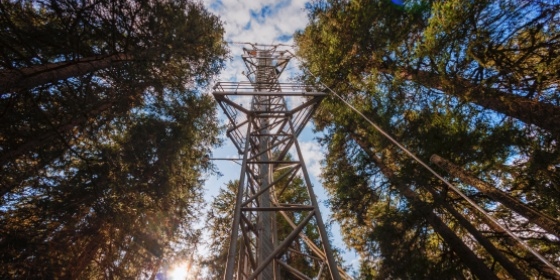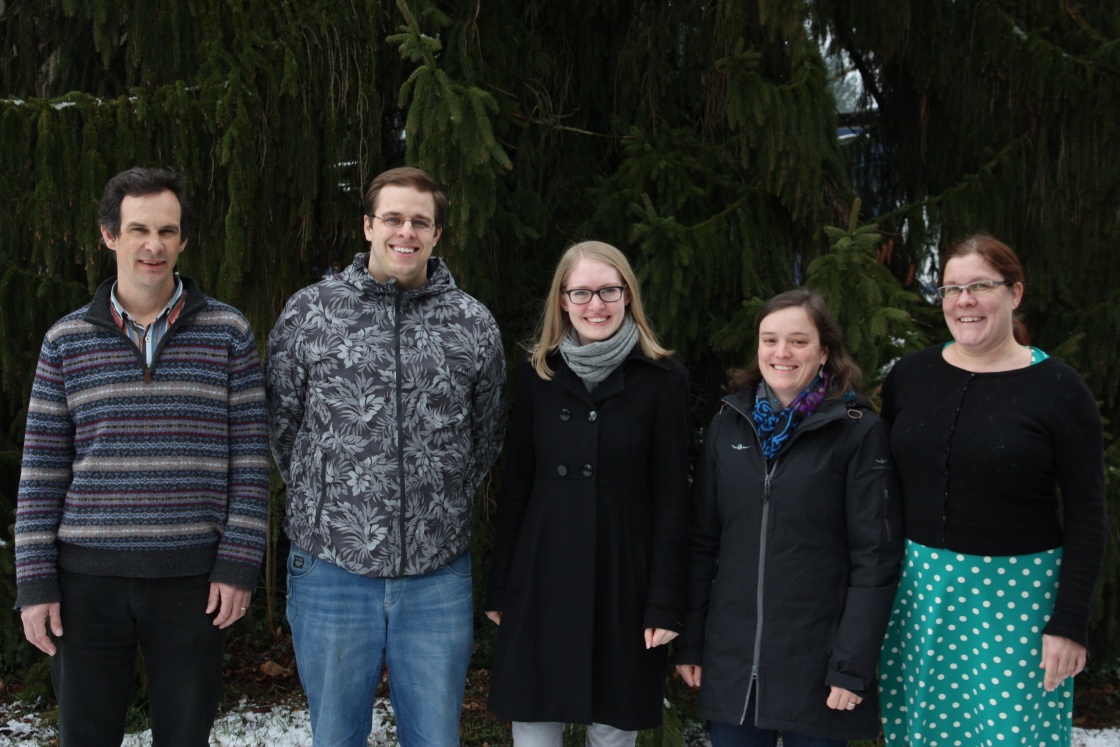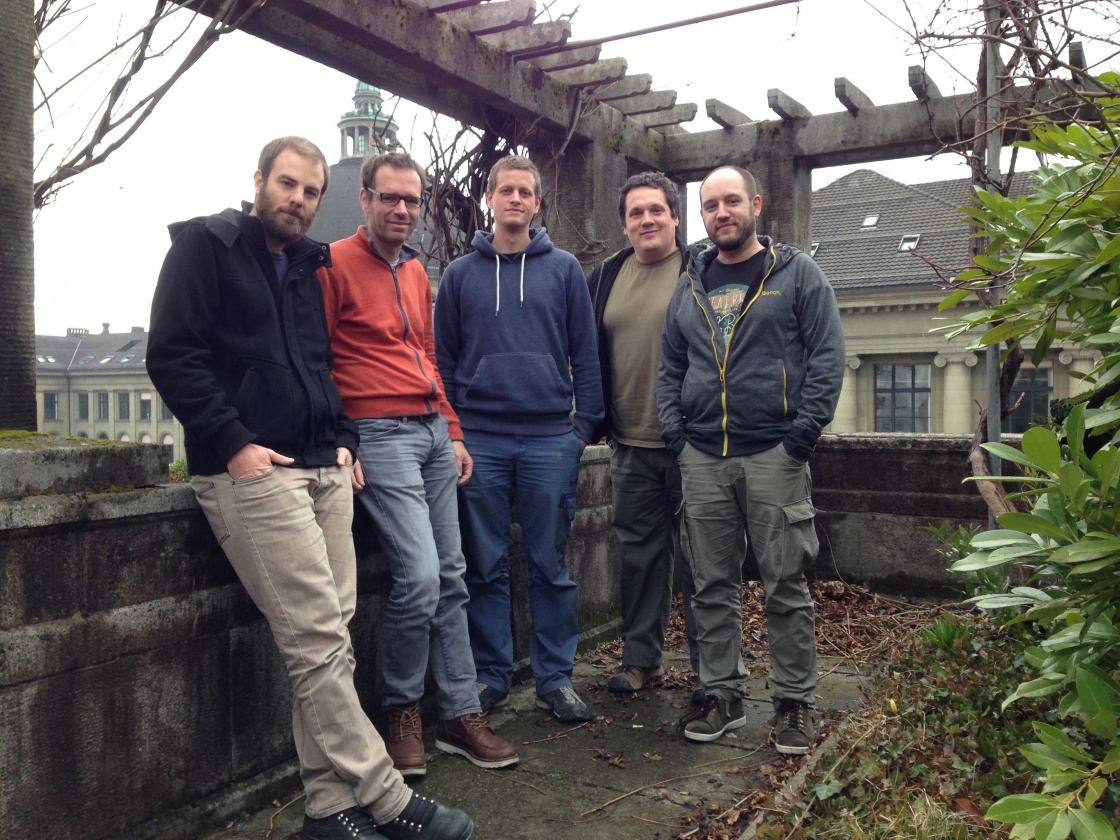
With the inauguration of ICOS ERIC in November 2015 the official station labeling process of the ICOS stations has been initiated and site Principal Investigator for CH-DAV Lukas Hörtnagl was the first ecosystem station PI who applied to become an official ICOS station.
CH-DAV is the code for the only subalpine coniferous forest observation station located near Davos in South-East Switzerland within the ICOS Ecosystem network. The site is one of the two ICOS stations (2nd station is the atmospheric site Jungfraujoch), which are contributed by Switzerland to the overall ICOS network.
To comply with ICOS standards, multiple protocols – of which most are finalized and adding up to 900 pages by now – need to be implemented in reality. In order to tackle this challenge a team of eleven persons based at two national research institutions – ETH Zurich and the Swiss Federal Institute for Forest, Snow and Landscape Research (WSL) – are currently active in Davos.
We asked the individual team members a few questions about their experience during the setup phase in Davos to highlight the opportunities and challenges one encounters when upgrading an existing environmental observation site to ICOS standards.

ICOS-CH team based at WSL from left to right: Peter Waldner (PW), Matthias Häni, Elena Haeler (EH), Susanne Burri (SB) and Anita Nussbaumer (AN), not on the picture Roman Zweifel (RZ)

ICOS-CH team based at ETH Zurich from left to right: Philip Meier (PM), Patrick Koller (PK), Florian Käslin (FK), Thomas Baur (TB) and Lukas Hörtnagl (LH – PI Davos)
Why was CH-DAV among many other environmental observations sites currently active in Switzerland chosen as ICOS ecosystem station?
LH: CH-DAV offers a unique combination of ongoing long-term measurements of regional climate, CO2 and microclimate profiles throughout the forest, tree physiological records such as sap flow and continuous stem radius changes, turbulent fluxes by eddy covariance, continuous atmospheric NO, NO2 and O3 concentrations, soil structure and vegetation properties such as crown transparency and litterfall. Eddy covariance measurements date back to 1997, making the dataset of CO2, H2O and energy exchange above the forest one of longest in the world. This availability of various long-term data streams at CH-DAV makes the site an ideal candidate for investigations about (missing) links between climate change, ecosystem fluxes, soil parameters and tree physiological adaptations.
How important is CH-DAV for Switzerland as well as within Europe for ICOS?
RZ: CH-DAV is very important for the forest ecosystem research in Switzerland since CH-DAV is probably the best equipped long-term monitoring forest site of Switzerland with a long history of research activities with international impact. CH-DAV links ICOS to other national and international forest ecosystem research as carried out in TreeNet, LWF, NABEL, ExpeER and ILTER.
LH: CH-DAV is one of only two forest sites in Switzerland that combine high-resolution eddy covariance measurements with tree physiological measurements, a combination that enables scientists to address comprehensive scientific research questions about ecosystem fluxes in detail. Thus, within ICOS CH-DAV can contribute to our understanding of the ecosystem dynamics of subalpine coniferous forests that are typical for the Central European Alps. Several Swiss research institutions cooperate to keep CH-DAV running throughout the year, making sure that incoming data comply with highest scientific standards needed for ICOS. Experiences from this joint operation at the research site in the past now help in the transition of CH-DAV to an ICOS Class 1 Ecosystem Station for its future operation within ICOS.
Since the Davos Seehornwald has long been an observation site at the WSL, can you briefly highlight the most important research results derived from the activities so far?
RZ: There is a long list of publications from CH-DAV and each of it has its importance. Personally, CH-DAV is the origin of my research career with the PhD-thesis ’The rhythm of trees’. It is further the place of birth of the project TreeNet with the initial publication about the link between net ecosystem productivity and the dendrometer-based tree growth.
You have had lots of experience in setting up eddy covariance stations so far. What makes the setup in Davos/ICOS setup for you especially interesting?
PM: Since ICOS covers a wide range of ecosystem measurements, which must be standardized, it is a good opportunity for a general site revision. We intend to reduce excessive wiring with replacing analog and serial data lines with an ethernet environment. Nice tools within the internet of things (e.g. Arduino, RaspberryPi, etc.) provide many useful features to remotely control the site. Last but not least, to gain knowledge in state-of-the-art techniques is always a benefit.
TB: Due to the basic restructuring of the Davos site the project gave us the opportunity to implement several ideas about eddy data acquisition we had in our minds for some time. These include better remote controlling, internet of things, new embedded systems, various new sensor types, new data structure, new variable name handling - the list is almost endless. Besides this technical aspect, it was great to get a wider knowledge about different methods to measure ecosystem processes and the knowledge you generate out of this data.
What has been your biggest achievement so far during the setup procedure?
TB & FK: Writing network based sensor data acquisition. Building up network-compatible chamber control units. So far both seem to run quite stable!
PM: We use a laser absorption spectrometer, measuring the concentrations of CH4 and N2O, for eddy covariance and chambers, sequentially. This requires a valve switching, which deals with different flows and pressure regimes and complex software. The software enables us to schedule tasks and control various instruments (QCL, Arduino, Flow-Meter) with diverse communication protocols. The system is extendable and the storage profile will be added this spring.
What are the main challenges in getting CH-DAV ready for ICOS?
TB & FK: Just the sheer amount of work. Don’t get lost in the various versions of protocols. Planning the tasks to keep the previous system up and running as long as possible while parallel updating or rebuilding the same systems. Travel distance from the office/workshop to the site (for Swiss standards) and snow/ice.
PM: The ICOS protocols! Being at the frontline means to implement the ICOS standards while the protocols are only being developed. Besides that, CH-DAV is one of the oldest EC-sites in Europe with important long-term data sets. To have as little as possible data gaps, working on this site is always an open-heart operation.
PW: A major challenge is the setup of a design and methods at the site that are as much as possible (1) in line with the ICOS protocols (which are still under development), (2) comparable to measurements of other large measurement networks such as the National Forest Inventory, the Pan-European International Cooperative Program on Assessment and Monitoring on Air Pollution Effects on Forests (ICP Forests) of UNECE, and (3) do not have destructive effects on running measurements or ongoing repetitions.
Which measurements are currently already covered by the WSL activities and what new measurements are performed during ICOS?
AN: The measurements at WSL include hemispherical photos for LAI, destructive vegetation sampling (understory) for green area index (GAI) and needle harvest for LMA and chemical analysis. Differences to the ICOS protocol include adjustments since the ICOS plots are established inside an existing monitoring area where destructive actions are prevented, GAI sampling plots were and will be defined outside the LWF site, and needle harvest is reduced to one collection per year at the end of the vegetation period due to the low growth rate at CH-DAV site (1650m a.s.l.).
PW: Within ICOS, WSL carries out measurements to regularly determine and characterize the aboveground C pools of the vegetation with methods that are comparable to those of the National Forest Inventory (5000 sites in CH) and the long-term Forest ecosystem research measurements (20 sites in CH and 200 sites in Europe). This includes tree inventories (stem wood), photosynthetically active green area (LAI above 1 m and destructive sample of ground vegetation/understory), the nutritional status of the trees (foliar sampling for chemical analyses) as well as nutrient input via precipitation and output with percolating soil water. In addition, automatic sapflow and stem growth measurements are carried out to continuously monitor tree physiological reactions and to better understand the short term variations in C uptake by trees.
Can you briefly highlight what your expectations from ICOS and ICOS data are for you as a researcher?
PW: An additional element of a coherent system for long-term measurement of effects on the C balance of ecosystems in Europe that combines high end as well as low cost technologies to cover Europe. ICOS is an occasion to join the effort of various research institutions in Europe that work in this research area.
SB & EH: We are looking forward to standardized scientific data and exciting possibilities to compare results from carbon cycle research among different European sites. Hopefully lots of other sites will be able to join in!
As highlighted by the answers from the scientific and technical personnel involved at CH-DAV it becomes clear that major efforts are undertaken to thoroughly understand a specific ecosystem such as the coniferous forest in Davos based on standardized data. CH-DAV is among few environmental super research sites in Europe, where ecological, physical, biological, hydrological and atmospheric research is merged to understand the ecosystem as a whole.
Further information on ICOS-CH: https://www.icos-switzerland.ch/ and http://www.gl.ethz.ch/research/bage/icos-ch.html and
Author:
Dr. sc. Lutz Merbold, ICOS-CH coordinator and Lecturer at ETH Zurich